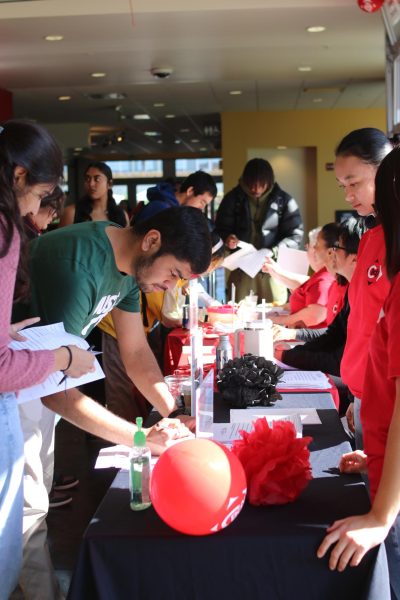Getting physical at CSUEB

2015 redesigned Pioneer logo.
The Freshman 15 is notorious: it is common for students who are new to campus to gain a few pounds during their first year in college. Realistically 3-5 pounds, is what a new student might gain due to lack of food portion control or from binge drinking, according to August 2017’s US News & World Report, and “forming good health habits now will serve you well in the years to come.”
In The Petite Advantage Diet, Jim Karas emphasizes habits that we develop in college help set up life routines after college. So as we move forward into the Fall quarter, it’s important to think about our food and exercise routines and come up with a plan to avoid the Freshman 15.
As a transfer student from Diablo Valley College, I work a quick morning shift at Perfect Tan & Hair Salon in Concord and then drive about 50 minutes from Concord to Hayward. I attend four classes at Cal State East Bay, then drive in about a 1 ½ hour commute home, make dinner for my family and then close my salon at 9 p.m. To avoid gaining those extra back to school pounds, I do 30-60 minutes of cardio/weights, eat a 300-400 cal dinner, study, and try to sleep eight hours. Our campus gym gives me confidence and makes me feel fit enough to have the stamina to walk all over our campus.
If we eat more calories than we spend, we gain weight, New York Times bestselling author, Jim Karas wrote in The Business Plan for the Body. “To lose 1 pound, you have to blast 3500 calories. You have to burn more calories than you consume to lose weight. Simple math,” says Karas in his #1 best selling book. Jim Karas is a weight-loss expert with a Wharton School of Business degree, author of three New York Times best-selling books and has been featured on Good Morning America, The View and The Dr. Oz Show.
Exercise has benefits like stabilizing blood pressure, combating stress, and reducing the risks of cancer, as found in Karas’ books. And it’s possible to work out in between classes. RAW has fitness classes every day in one of its two fitness studios. Yoga, Zumba, boot camp and body sculpt are some of the classes offered at RAW.
The bottom floor of the RAW center has three sets of free weights and 10 weight machines, and 30 cardio machines, such as treadmills, stair climbers, and ellipticals upstairs, according to Tim Hwang, a fitness attendant at the RAW center.
The RAW center also has a quiet wellness room where students can study alone or with a small group. Rackets, towels, and sports equipment are all available, RAW officials confirmed.
Exercise stimulates brain development, increases memory retention and builds confidence, says Harvard Medical School’s 2014 Family Health Guide. Improved learning, stable mental health and the ability to maintain a fabulous fit figure can occur when endorphins get released which naturally suppresses an appetite and improves moods. The Harvard publication also shows sleep quality and a boost to brain power to be additional benefits of this potentially positive health addiction.
Karas emphasizes that exercise is 25 percent and nutrition is 75 percent to staying fit. Jamba Juice, next door to RAW, has 16 oz Jamba Juices that have protein and you can opt for almond milk in lieu of a juice. P.O.D.(Products On Demand) mini-mart on campus sells Larabar or Be Kind Bars-around 160-200 calories-as well as carrots and hummus, and almonds. Starbucks has a protein ½ chicken wrap which is 230 cal and a nonfat tall unsweetened green tea latte is 210 cal as low cal snacks.
Some quick exercises I like to do are: climbing upstairs for 15 min, burns 150 calories, walking from parking lot-30 min-129 calories-, 10 minutes of stretching in between classes-48 calories-, or sitting at my desk & lifting up knees 15 reps,3 times-25 calories. RAW has sign-ups for intramural sports: one hour soccer-340-650 cal-, one hour Basketball-(340-650 cal), or one hour Volleyball-136-476 calories. Fifteen minutes boxing, punching a bag burns 85 calories, and RAW has gloves and a punching bag.











